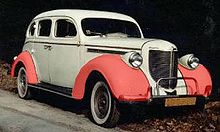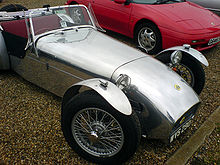- Fender (vehicle)
-
For the part of an automobile designed to absorb minor impacts, see Bumper (automobile).
Fender is the US English term for the part of an automobile, motorcycle or other vehicle body that frames a wheel well (the fender underside). Its primary purpose is to prevent sand, mud, rocks, liquids, and other road spray from being thrown into the air by the rotating tire. Fenders are typically rigid and can be damaged by contact with the road surface. Instead flexible mud flaps are used close to the ground where contact may be possible.
Sticky materials such as mud may adhere to the smooth outer tire surface, while smooth loose objects such as stones can become temporarily embedded in the tread grooves as the tire rolls over the ground. These materials can be ejected from the surface of the tire at high velocity as the tire imparts kinetic energy to the attached objects. For a vehicle moving forward, the top of the tire is rotating upward and forward, and can throw objects into the air at other vehicles or pedestrians in front of the vehicle.
In British English, the fender is called the wing (this usually only refers to the panels over the front wheel arches, in modern cars, since the rear 'fenders' are more an integral part of the car's body shape). The equivalent component of a bicycle or motorcycle, or the "cycle wing" style of wing fitted to vintage cars which is not integral with the bodywork, is called a mudguard in Britain, as it guards other road users - and in the case of a bicycle or motorcycle, the rider as well - from mud, and spray, thrown up by the wheels. However, the term mudguard appears to have been in use in the U.S. at one point. The American author E.B. White, in an October 1940 Harper's essay, Motor Cars, refers to "...mudguards, or 'fenders' as the younger generation calls them." [1]
In German, it is known as a Kotflügel.
In the United States, a minor car accident is often called a "fender bender".
Contents
Trucks and automobiles
In current US auto industry nomenclature, usually only the panels over the front wheels are called fenders. The auto industry changed from rear fenders bolted onto a quarter panel to an enlarged welded on quarter panel that fulfilled both functions. There then was only one piece where there had previously been two, and name of the larger welded piece, the quarter panel, survived the consolidation.
The bolted panel which covers the wheel on dual rear wheel pickup trucks is called a fender. A pickup truck with a separate bed but without bolt on fenders has a bedside, which performs the function of a fender. When the side of the bed is welded to the cab, as with the Cadillac Escalade and Chevrolet Avalanche, it is called a quarter panel.
While the standard of bolted versus welded normally applies, there are some exceptions. Although attached by welding, the panels over the front wheels on cars such as the early 60s Lincoln Continental, the Corvair, and the early 60s Chrysler Imperial are called fenders. Similarly, even though bolted on, the panels covering the rear wheels on the Saturn S series are called quarter panels.
A common accessory on pick up trucks are fender flares, which blocks mud and stones and/or covers rust. They are sometimes used by manufacturers on models that have wider tires than basic models. Using this method, the manufacturer can provide the needed tire coverage without having to stamp a different metal fender, bed side, or quarter panel for what may be a relatively low production model.
The terms have evolved to be determined mostly based on location. Fenders are at the front. Quarter panels are at the rear, with an exception made for dual rear wheel trucks, where the panel at the rear is called a fender.
For vehicles with a narrow car body that exposes the tire, the fender is an exposed curve over the top of the tire. For wide body vehicles that cover the tire, the fender forms the wheel well surrounding the tire, and is not directly visible from above the car body.
Wheel wells tend to be much larger than the diameter of the tire, because they do not move with the tire suspension and consequently must be large enough to allow the full range of tire motion on the suspension without touching the interior of the wheel well. More elaborate designs include fender skirts for enclosing the outside edge of the wheel well, and stylized pontoon fenders for exposed fenders.
Certain types of cars with narrow bodies, such as the Lotus Seven, Allard, and Caterham Seven, use what are called cycle fenders in the US or cycle wings in Britain, for their resemblance to those used on bicycles. They are attached to the wheel suspension and remain at a fixed distance from the tire regardless of wheel motion, and can therefore be much closer to the tire than fixed wheel wells. This was popular on early Classic Trials cars because the fenders were lightweight and allowed for a thin streamlined body. They persist on cars wanting a "vintage" look.
Bicycles and motorcycles
There are generic fenders for bicycles that can be fitted to most bicycle frames. These catch and redirect road spray thrown up by the tires, allowing the rider to remain relatively clean. They are relatively uncommon on bicycles in the more car dependent English-speaking countries, as bikes in these countries tend to be sports-oriented, with minimal clearance between tires and frame tubes for fenders, or are only ridden in clement conditions, although there are a few fenders that are designed to be attached to the seat post. However, European utility bicycles, traditional roadsters used in developing countries, serious touring bicycles, and beach cruisers are nearly always fitted with fenders, universally known in British English as mudguards. They are also fitted to motorcycles.
In the UK it is a legal requirement that a motorcycle should be fitted with mudguards[citation needed]. While motorcycles are invariably fitted with mudguards, only touring cycles generally have fully functional mudguards. Some machines can be seen with a stub of a mudguard only a few inches long, which satisfies the legal requirements but does not actually provide any protection from thrown mud and spray.
Sporty-styled or racing motorcycles sometimes come with, or have added as an aftermarket accessory, a "hugger" rear fender, attached to the rear swingarm and very close to the tire, rather than attached to the rear subframe and away from the tire.[2][3] Conversely, the practice of removing the front fender and reducing the size of the rear fender produced the bobber customization style of the 1950s onwards.
See also
- Quarter panel
- Wing mirror
- Curb feeler
- Mud flap
- Fender skirts
Notes
- Motor's Crash Estimating Guide October 1972 Vol. 4, No. 10
- Motor's Crash Estimating Guide June 1971 Vol. 3, No 6
References
- ^ White, E.B. (1997), One Man's Meat, p. 151, ISBN 0-88448-192-1
- ^ Seeley, Alan (2004), The Motorcycle Book: Everything You Need to Know about Owning, Enjoying, and ..., p. 116, ISBN 9780760317457, http://books.google.com/?id=gX9uopenItAC&pg=PA116&dq=motorcycle+hugger, "Most monoshock bikes have very little protection from road dirt the elements for the rear shock and linkages. A hugger mounted to the swingarm will reduce the amount of water and muck being thrown at the shock, swingarm, and back of the engine. Most replace the standard chainguard too."
- ^ The word "Hugger" was also used in the name of a Harley-Davidson Sportster model of 2001
List of bicycle parts Frame Handlebars · Stem · Head tube · Headset · Fork · Seatpost · Saddle · Bottom bracket · Dropout · Suspension
Wheels Drivetrain Cabling Peripherals Basket · Bell · Bottle cage · Fairing · Cyclocomputer · Kickstand · Lighting · Luggage carrier · Mudguards · Pannier · Saddlebag · Reflectors · Skirt guard · Training wheelsCategories:- Automotive body parts
- Bicycle parts
- Motorcycle technology
Wikimedia Foundation. 2010.



